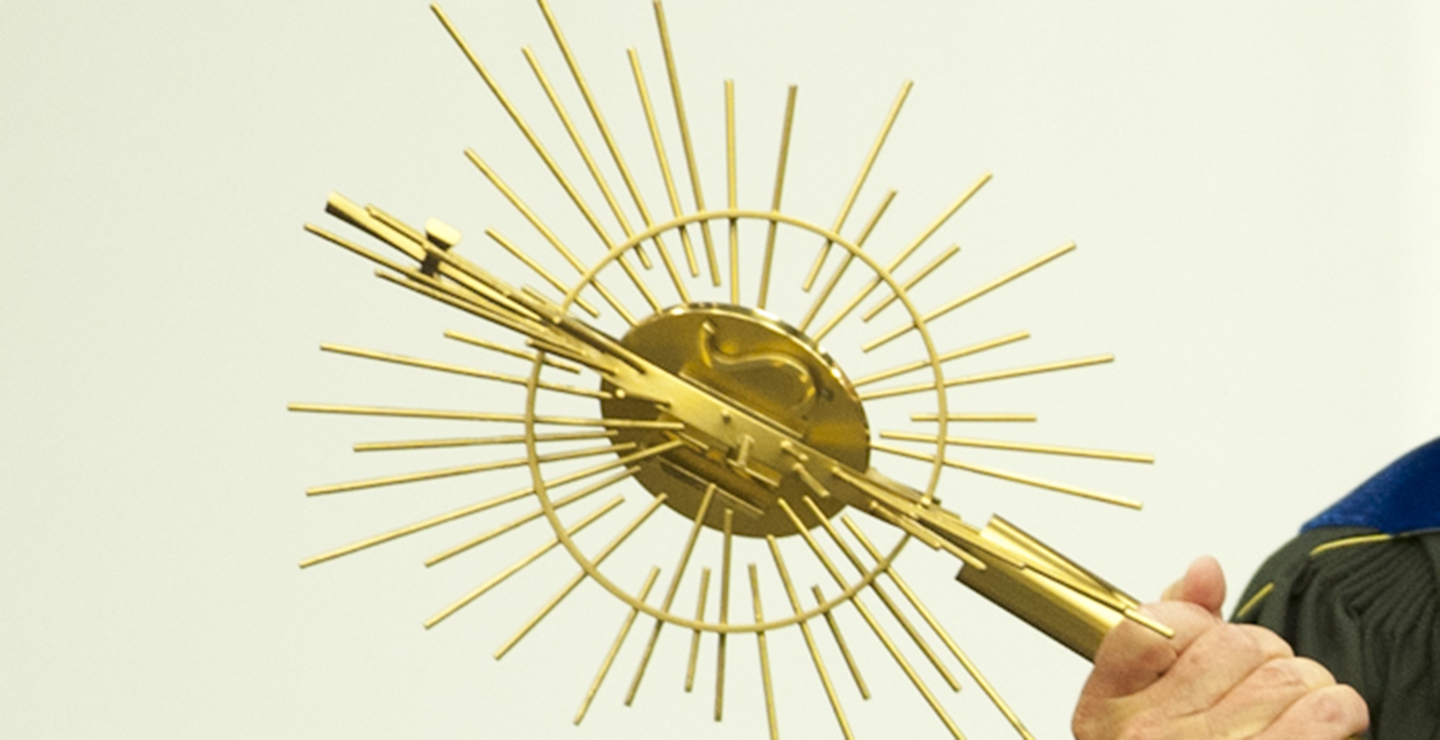Siena College Mace and presidential Medallion
Siena’s mace and the Presidential medallion are visible components of the College’s ceremonial tradition.
The mace is approximately four feet long and eight inches wide at the top. It is made of polished bronze with a satin finish. The seal of Siena College, which is the monogram of the Holy Name of Jesus, IHS, surmounts the head of the mace. This rendition is copied from the bronze sculpture above the front entrance to the Siena friary. Two bands, intersecting at right angles, surround the bronze disk at the top of the mace. To the artist, Otello Guardicci, who designed the work on which the mace is based, the disk represented Christ in the Eucharist; the area within the circle represents the unity of God. Many rays radiating from the center symbolize the glory of God. Guardicci called the original work “The Sun.”
Devotion to the Holy Name of Jesus was one of the notable characteristics of St. Francis and his order. The devotion crystallized when St. Bernardine of Siena popularized it in the 15th century and made the material object of this devotion the monogram of the Holy Name. IHS are the first three letters of the name Jesus (Iota-Eta-Sigma) in Greek.
The mace’s base includes both the seal of the Order of Friars Minor and the seal of the College.
This mace is a gift from Nancy and Thomas D. O’Connor. Mr. O’Connor was chairman of both the Siena Board of Trustees and the Presidential Search Committee when Fr. William E. McConville was selected as the College’s eighth President.
Siena’s seventh President, Fr. Hugh F. Hines, O.F.M., was the first to wear the Presidential medallion. The pewter medallion bears the College seal on one side and the Franciscan coat of arms on the other.
The Franciscan coat of arms first appeared in art in the 16th century. Reflection on the great event of Francis’ life, the receiving of the Stigmata, the wounds in his body like those of Christ on the Cross, prompted a variety of insignia. On the Franciscan coat of arms the habited arm is that of Francis, the other that of Christ; Francis became one with Christ through a life of prayer, penance, and service. The crossed arms invite his followers to do likewise.
Academic Regalia
The academic costume is derived from the garments worn at medieval universities. The gowns and the hoods were common at British universities before the 14th century; the square cap is thought to be a 16th century import from the University of Paris. From the color and the size of the American academic attire one may determine the institution from which the wearer received the degree, the degree earned, and the academic rank.
The bachelor’s gown is usually black with pointed sleeves of almost knee length; the master’s gown has oblong sleeves reaching well below the knees, but a slit just above the elbow to allow the forearms to protrude; the doctor’s gown is faced with velvet and has full bell-shaped sleeves, each bearing three horizontal bars of velvet. The trim may be either black or a color distinctive of the degree.
The Trustees of the College wear the black academic gown with deep rich green bars and gold piping. Green and gold are the Siena colors, the gold symbolizing the quality of the education, the green, the hope of the future. The President’s gown is green, with gold panels, cut in the traditional presidential pattern, with long, belled sleeves displaying four gold bars.
The Siena Trustees and President wear the Dutch style black hat with a gold tassel. The President also wears a pewter medallion bearing the College seal on one side and Franciscan cross arms on the other.
The length of the hood also indicates whether the wearer is a bachelor, master or doctor. The silk lining of the hood is colored with the official colors of the institution conferring the degree, and the velvet border of the hood is colored according to the degree granted: white for arts and letters (Bachelor of Arts degree); drab for business areas (Bachelor of Business Administration degree); yellow gold for science (Bachelor of Science degree); dark blue for philosophy (Ph.D.); light blue for education; brown for fine arts; purple for law; citron for social service; scarlet for theology.
In 2004, a number of alumni, many of whom have represented Siena College at inaugurations of new college and university presidents, contributed to a fund to purchase new academic regalia for the use of our trustees, associate trustees, and honorees. Siena College is grateful for their thoughtful generosity.
